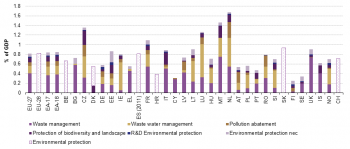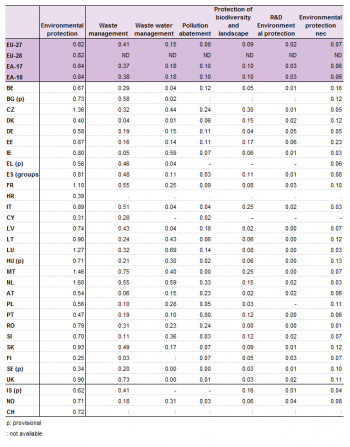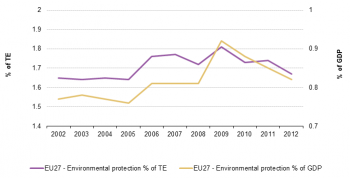Archive:Government expenditure on environmental affairs
EU-27 government expenditure on environmental protection at 0.82 % of GDP in 2012
Statistics in focus 9/2014; Authors: M. ASSUNÇÃO, L. FREYSSON, M. GAPINSKA, M. MAROTTA, I. KOSTADINOVA, L. WAHRIG
ISSN:2314-9647 Catalogue number:KS-SF-14-009-EN-N
This article is outdated and has been archived. For recent articles on Government finance, please see here,
In the framework of the European System of National Accounts (ESA95), Eurostat collects data on general government expenditure by economic function according to the international Classification of the Functions of Government (COFOG) – see methodological note.
This publication presents for the first time detailed COFOG data on environmental protection for the European countries. This became possible due to progress in the availability and quality of voluntarily transmitted COFOG level II data.




Main statistical findings
In 2012, EU-27 total general government expenditure amounted to 49.4 % of GDP. Based on the latest available expenditure data by economic function for 2012, expenditure on environmental protection as a ratio of GDP amounted to 0.82 % in the EU-27. For the EU-27, this ratio has been decreasing for the last three years (see Figure 1).
Of total government expenditure on 'environmental protection', around half was dedicated to 'waste management' (0.41 % of GDP in the EU-27 in 2012).
EU-27 general government expenditure on environmental protection in 2012
Government expenditure on environmental protection amounted to around EUR 106 billion in 2012 in the EU-27.
As a ratio to GDP, in 2012 the highest levels of government expenditure on environmental protection among the reporting countries were found in the Netherlands (1.68 % of GDP), Malta (1.46 % of GDP) and the Czech Republic (1.36 % of GDP). The lowest ratios were observed in Finland (0.25 % of GDP), Cyprus (0.31 % of GDP) and Sweden (0.34 % of GDP).
The share of expenditure dedicated to environmental protection (see Figure 2) in the EU-27 has been relatively stable since 2002, ranging between 1.64 % and 1.81 % of total expenditure, with the decrease in the recent years due to active measures taken by countries to reduce total expenditure. In the environmental affairs division, this mainly concerns decreases in 'other current transfers' and capital investments.
Expenditure on 'waste management', which covers the collection, treatment and disposal of waste, makes up around half of government expenditure on environmental protection in the EU-27 in 2012 or 0.82 % of total government expenditure (TE). While expenditure on 'waste management' made up 1.73 % of TE in Malta, 1.63 % of TE in Bulgaria and 1.54 % of TE in the UK, at the other end of the scale, it constituted only 0.05 % of TE in Finland, as shown in Table 1.
For 14 out of the 27 Member States analysed, 'waste management' was the COFOG group where most expenditure was made. In Cyprus 'waste management' made up 92.42 % of total expenditure in environmental protection, while in Ireland it accounted for only 6.47 %.
Expenditure on 'waste water management', which represented the second largest share, made up 0.30 % of total government expenditure in 2012 in the EU-27, making up 1.56 % of TE in Luxembourg. In Ireland, 'waste water management' made up 73.25 % of government expenditure on environmental protection.
Expenditure on 'protection of biodiversity and landscape' made up 0.18 % of TE in the EU-27. At the higher end of the range, the Czech Republic devoted 0.66 % of TE to 'protection of biodiversity and landscape', in contrast to Romania and Cyprus, which did not dedicate any expenditure to this COFOG group. Denmark devoted 38.33 % of its expenditure on environmental protection to 'protection of biodiversity and landscape'.
Expenditure on 'pollution abatement' made up 0.17 % of TE in the EU-27, with the Netherlands devoting 0.66 % of TE, and Austria devoting 42.34 % of their expenditure on environmental protection, to this COFOG group.
Expenditure on R&D on environmental protection was rather low in 2012, making up only 0.05 % of TE in the EU-27, 0.15 % in Estonia and less than 0.01 % in seven Member States.
Expenditure on the 'not elsewhere classified group' is around 8.98 % of the total expenditure on environmental protection in the EU-27.
The amounts of expenditure recorded under environmental protection can be strongly influenced by the inclusion of large amounts of negative expenditure due to sales of Assigned Amount Units (AAUs), which are recorded as a disposal of a non-financial non-produced asset. In 2012, Bulgaria, the Czech Republic (both in 'environmental protection not elsewhere classified'), Poland and Norway (both recorded in 'pollution abatement') recorded a disposal of this type of asset.
Government expenditure on 'environmental protection' decreased between 2009 and 2012
As a ratio to GDP, government expenditure on 'environmental protection' increased from 2002 (0.77 % of GDP), reaching its peak in 2009 (0.92 % of GDP), and then decreasing until 2012 (0.82 % of GDP).
In absolute terms, government expenditure on 'environmental protection' decreased by around EUR 2 billion EUR from 2009 to 2012, after having increased by around EUR 32 billion from 2002 to 2009, in parallel with the overall evolution of government total expenditure in EU-27 in the period 2002-2012 (Figure 2).
The evolution at the level of the EU masks disparate developments in the Member States. While total expenditure on environmental protection decreased by 0.4 percentage point (pp) of GDP in Bulgaria and 0.3 pp of GDP in Ireland and Lithuania over the 2009 to 2012 period, it increased by 0.7 pp in the Czech Republic and 0.6 pp in Latvia. However, the expenditure amounts in 2009 for Czech Republic and Latvia are negatively biased by the sale of AAUs.
Intermediate consumption is the most important component of expenditure on environmental protection
In the EU-27 in 2012, ‘intermediate consumption’, for instance on small tools, maintenance of fixed assets and services purchased from corporations outside general government, accounted for the largest share of expenditure on environmental protection (around 50 % of total expenditure), clearly influenced by the 70 % of total expenditure on 'waste management' (see Figure 3).
Apart from ‘intermediate consumption’, ‘capital investments’ and ‘compensation of employees’, each accounting for 19 % of total expenditure on environmental protection, were important expenditure components.
Data sources and availability
Reporting of data to Eurostat
Annual government finance statistics (GFS) data are collected by Eurostat on the basis of the European System of Accounts (ESA95) transmission programme. Member States are requested to transmit, among other tables, table 1100, 'Expenditure of general government by function' twelve months after the end of the reference period. Table 1100 provides information about expenditure of the general government sector divided into main COFOG functions and ESA95 categories. The transmission of the COFOG I level breakdown (divisions) is compulsory for the years 1995 onwards, whereas information on the COFOG II level (COFOG groups) is provided on a voluntary basis. The main reference years used in this publication are 2012 as the latest year available and 2002 as the first year for which complete data on expenditure by function are available at EU-27 level.
Data was extracted on 07 March 2014.
Provisional data
Data for Bulgaria (BG), Greece (EL), Hungary (HU), Iceland (IS) and Sweden (SE) (2012 only) is provisional.
Definition of general government and its sub-sectors
The data relate to the general government sector of the economy, as defined in ESA95, paragraph 2.68: 'All institutional units which are other non-market producers [institutional units whose sales do not cover more than the 50 % of the production costs, see ESA95 paragraph 3.26] whose output is intended for individual and collective consumption, and mainly financed by compulsory payments made by units belonging to other sectors, and/or all institutional units principally engaged in the redistribution of national income and wealth’.
Classification of functional expenditure of government
The Classification of the Functions of Government (COFOG) classifies government expenditure into ten main categories (divisions known as the 'COFOG I level' breakdown): general public services; defence; public order and safety; economic affairs; environmental protection; housing and community affairs; health; recreation, culture and religion; education; social protection. These divisions are further broken down into 'groups' (COFOG II level).
Further information is available in the Eurostat Manual on sources and methods for the compilation of COFOG Statistics.
COFOG level II data
COFOG level II data is published only in agreement with the country concerned. The development of COFOG level II data is not completed in many Member States and data needs to be looked at with this in consideration. The transmission of COFOG level II data for the general government will become compulsory by the end of December 2014.
For Belgium (BE) and Slovakia (SK), COFOG group data is available but not published. For Denmark (DK), data for COFOG groups 05.1, 05.2, 05.3, 05.5 and 05.6 is available, but not published. For Spain (ES), COFOG group data is available for 2012, but not published pending the availability of more final data.
Satellite accounts
Administrative expenditure data is additionally collected in so-called satellite accounts. As regards environmental accounts, Eurostat has recently established a wide-reaching data collection following the CEPA 2000 classification. In general, the amount of expenditure recorded in satellite accounts is expected to exceed the expenditure recorded under the respective COFOG division, as the COFOG classification focusses on recording expenditure by primary function.
Definition of general government expenditure
Government expenditure is defined in Commission Regulation 1500/2000 which uses as reference a list of ESA95 categories: Government expenditure comprises the following categories:
- P.2, 'intermediate consumption': the purchase of goods and services by government;
- P.5, 'gross capital formation' consists of: (a) gross fixed capital formation (P.51); (b) changes in inventories (P.52); (c) acquisitions less disposals of valuables (P.53); where
- P.51, 'gross fixed capital formation': consists of acquisitions, less disposals, of fixed assets during a given period plus certain additions to the value of non-produced assets realised by the productive activity of producer or institutional units. Fixed assets are tangible or intangible assets produced as outputs from processes of production that are themselves used repeatedly, or continuously, in processes of production for more than one year;
- D.1, 'compensation of employees': the wages of government employees plus non-wage costs such as social contributions;
- D.29, 'other taxes on production, payable',
- D.3, 'subsidies, payable',
- D.4, 'property income, payable', consists of : (a) 'interest, payable' (D.41) and (b) 'other property income, payable' (D.42+D.43+D.44+D.45), where
- D.41, 'interest': excludes settlements under swaps and forward rate arrangements, as these are treated as financial transactions in the ESA 95;
- D.5, 'current taxes on income, wealth, etc, payable';
- D.62, social payments: cover social benefits and pensions paid in cash;
- D.6311, D.63121, D.63131, 'Social transfers in kind related to expenditure on products supplied to households via market producers';
- D.7, 'other current transfers, payable';
- D.8, 'adjustment for the change in net equity of households in pension fund reserves'
- D.9, 'capital transfers payable'
- K.2, 'acquisitions less disposals of non-financial non-produced assets': public investment spending. Non-financial non-produced assets consist of land and other tangible non-produced assets that may be used in the production of goods and services, and intangible non-produced assets.
- Capital investments includes P.5 and K.2.
- Other current expenditure includes D.7, D.29, D.5 and D.8.
Gross Domestic Product
Throughout this publication, nominal GDP, i.e. GDP at current prices is used.
Time of recording & symbol
In the ESA95 system, recording is in principle on an accrual basis, that is, when ‘economic value is created, transformed or extinguished, or when claims and obligations arise, are transformed or are cancelled'.
"ISCED" International Standard Classification of Education (1997)
":" not available
"p" provisional
"pp" percentage points
More data and information
For more country-specific notes, e.g. on missing data, please refer to the metadata published on Eurobase. The authors can be contacted at ESTAT-ESA95-GOV@ec.europa.eu
Context
In the framework of the European System of National Accounts (ESA95), Eurostat collects data on general government expenditure by economic function according to the international Classification of the Functions of Government (COFOG) – see methodological note. This publication presents for the first time detailed COFOG data on environmental protection for the European countries. This became possible due to progress in the availability and quality of voluntarily transmitted COFOG level II data.
See also
- Environmental protection expenditure
- Evolution of government expenditure by function
- Government expenditure by function – COFOG
- Government expenditure on education - 2011 results
- Government expenditure on education - 2012 results
- General government expenditure on social protection and health
- Government expenditure on economic affairs
Further Eurostat information
Publications
Main tables
Database
Dedicated section
Methodology / Metadata
- General government expenditure by function (COFOG) (ESMS metadata file — gov_a_exp_esms)
- Manual on sources and methods for the compilation of COFOG statistics - Classifications of the Functions of Government - 2011 edition